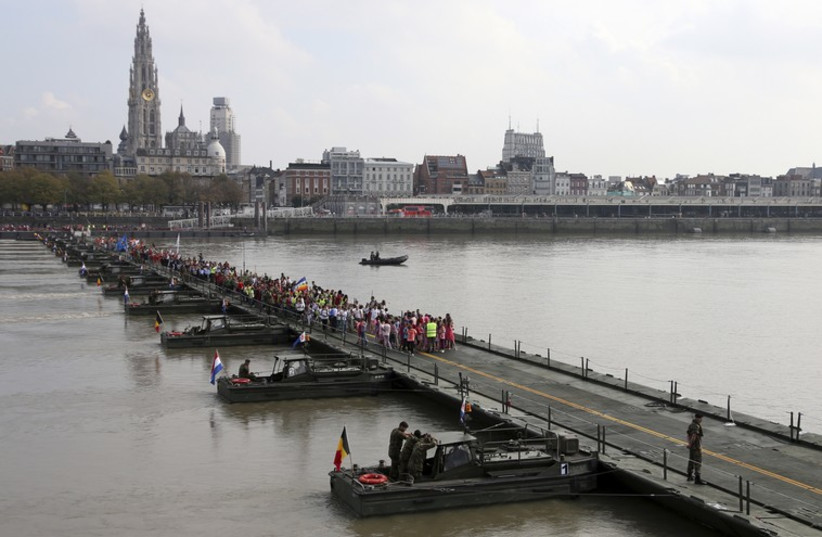In the 16th century, according to Michael Pye, the residents of Antwerp had a choice of two fantasies. With its many languages, faiths and nationalities, their city could be a modern Babylon. Or, given its dignity and importance, Antwerp could be deemed the new Rome.
The reality, Pye implies, was no less interesting. Antwerp’s alliance with England brought wool to the region. Along with the subsequent trade throughout Europe and the Levant (nine-tenths of the cloth England exported went through Antwerp), came influential contacts and opportunities to develop new techniques of finance.
Although they “had no army, no empire and an imperial overlord” who demanded orthodoxy, Antwerp’s locals protected merchants and artisans (Calvinists, Lutheran Germans, Anabaptists and converso Jews from Portugal, only nominally converted to Catholicism) who brought them prosperity and prestige.
In Europe’s Babylon, Pye (whose previous books include The Drowning Room, The Pieces from Berlin, and The Edge of the World: A Cultural History of the North Sea and the Transformation of Europe) provides a lively, informative account of Antwerp in its golden age. Pye acknowledges that the destruction of town records in a fire set by Spanish soldiers in 1576 hampers historians’ efforts to “make secure statements” about events, disputes, elections and municipal finances. And so, he has turned to paintings, books, court records, laws and the reflections of diplomats and foreigners to observe Antwerp “from a hundred angles, many of them oblique.”
Pye is a gifted storyteller. Like other great trading cities “with tight filthy streets that made a convenient dormitory for rats,” he reveals, Antwerp was especially susceptible to plagues but had to “live close to death or not at all.” Magistrates forbade meals with more than 10 people, restricted trips to the market to one person from a sick house, shuttered schools, banned pigs, considered using tides to clean canals and told residents “to make confession and be in a state of grace at all times.”

Europe’s Babylon is full of colorful characters. Simone Turchi, we learn, was a sponger with a vicious tongue and a propensity to set friends against each other, who nevertheless managed to convince bankers to use him to conduct their Antwerp affairs. With a bag of gunpowder tied to his back and another on his chest, Turchi was executed in the trick chair (equipped with iron bars that shot out from armrests to fasten thighs) he had used to murder Geronimo Deodati, the rather genteel banker who had earned his enmity by advancing him large loans and then sending him to jail.
MISTRUSTED BY clients and hated by neighbors, Gaspar Ducci, Pye asserts, had no nationality that mattered or loyalty to a king, duke, state, city, or flag. Banned from Antwerp’s bourse for three years for cornering the city’s money he returned with “street-corner toughs,” served the Queen gilded oysters on dishes crusted with pearls, bought a country estate and title from agents of William of Orange, looked for deals in herring to enrich himself while helping finance alliances and wars. Defying old-fashioned notions of trade, Ducci “could hardly have made a career anywhere but Antwerp.”
And, according to Pye, only Antwerp could serve as host to the publisher Christophe Plantin, whose name appeared on 2,450 books, printed in lots of languages, including Hebrew. And Abraham Ortelius, whose Theatrum Orbis Mundi “was an atlas before Mercator invented the term.”
All that said, Pye’s episodic and anecdotal narrative does not generate sufficient support for his claim that Antwerp, like 19th-century Paris and 20th-century New York, “helped change the world and how we think about it.”
Pye does not adequately analyze the relative power, formal and informal, of local magistrates, the Spanish governor of the Netherlands, and the Hapsburg monarchy. Nor did he its boom-and-bust economy. He focuses most of his attention on affluent men in commerce, artists and writers, a relatively small fraction of the population.
Pye suggests that women had more freedom in Antwerp than elsewhere but provides no comparative evidence. He indicates that more Africans lived in Antwerp than in any European city except Lisbon but does not address their experiences. He claims that Jews who had fled the Inquisition in Portugal found life congenial in Antwerp, “which quietly tolerated a wholesale defiance of heresy laws, making it hard to arrest or prosecute” anyone obeying Jewish laws, while acknowledging that treatment of poor Jews was less generous, and toleration was suspended when during one of his (many) tantrums, Charles V issued orders to expel them.
Antwerp’s golden age ended when the Spanish regained control of the city in the last third of the 16th century. A visitor to the city in 1616 admired the “beauty and uniformity of its buildings,” but found it quiet even on workdays, with grass growing in the streets, and Jesuit teachers living in old traders’ houses.
Antwerp, Pye concludes, with characteristic elegance, and, alas, exaggeration “had once been the hub of the whole world that Europeans knew… But it was only a city, a site with walls that was liable to rise and fade with time. It could be hollowed out; and it was.”■
The writer is the Thomas and Dorothy Litwin Professor of American Studies at Cornell University.
Europe’s Babylon
By Michael Pye
Pegasus Books
272 pages; $28.95
![IN THE 1500s, Antwerp’s port [seen 2018] was one of the most influential in the world. IN THE 1500s, Antwerp’s port [seen 2018] was one of the most influential in the world.](https://images.jpost.com/image/upload/f_auto,fl_lossy/q_auto/c_fill,g_faces:center,h_720,w_1280/498164)